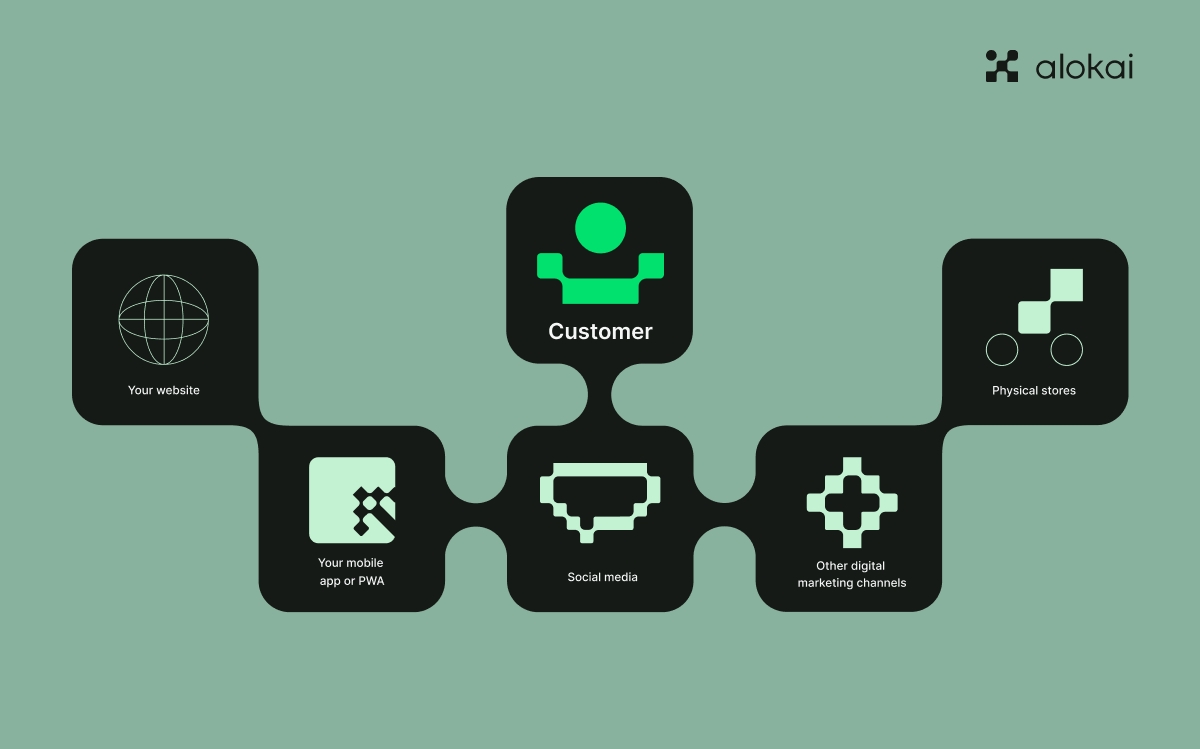What exactly is omnichannel commerce, and how can it revolutionize your customer’s shopping experience? At its core, omnichannel commerce integrates multiple sales and marketing channels to deliver a seamless customer experience, whether online, in-store, or mobile. But beyond the definition, businesses are searching for its scalable potential – the ability to engage with customers more deeply and cohesively than ever before. This guide will explore strategies, challenges, and technologies that drive successful omnichannel commerce, setting the stage for increased customer loyalty and business growth.
Key takeaways
- Omnichannel commerce is all about providing a consistent and seamless experience across all sales channels, from online to brick-and-mortar, increasing customer loyalty and sales.
- Creating an effective omnichannel strategy involves understanding your audience, integrating sales channels for a unified presence, and utilizing data for personalized experiences.
- Challenges in omnichannel retail include managing customer expectations, balancing digital and physical store priorities, and providing seamless customer service to enhance satisfaction and loyalty.
Exploring the essence of omnichannel commerce
Omnichannel commerce is all about creating a seamless and unified customer experience across all sales channels. Whether a customer is shopping online from a desktop or mobile device, via telephone, or in a brick-and-mortar store, their experience should be consistent and complementary. The goal is to blur the lines between different sales channels and make the transition from one channel to another as smooth as possible.
This approach enhances the customer’s shopping experience and increases their engagement with the brand, leading to higher customer loyalty and, ultimately, increased sales.
The rise of omnichannel customers
Our modern retail landscape has created a new kind of customer: the omnichannel customer. These customers, who use multiple channels to engage with brands, have higher expectations than traditional customers. They demand a seamless and consistent experience across all platforms and expect businesses to meet them where they are, whether online or in-store.
By adopting an omnichannel approach, businesses can meet these expectations and ensure their customers remain satisfied and loyal.
The Evolution from single-channel to omnichannel
The journey from single-channel to omnichannel commerce wasn’t a sudden revolution but a gradual evolution driven by shifts in consumer behavior and technological advancements. Single-channel commerce, which focuses on a single sales avenue, restricts businesses by not tapping into other available channels.

While spanning multiple channels, multichannel commerce lacked an integrated approach, leading to a disjointed customer experience. Omnichannel commerce, the next step in this evolution, involves multiple sales channels and seamlessly integrates them to provide a unified experience for customers.
Crafting an effective omnichannel strategy
Crafting an effective omnichannel strategy requires more than just integrating multiple sales channels. It’s about:
- Understanding your target audience
- Leveraging data for personalization
- Adapting to changing customer needs
- Conducting a deep dive into customer behavior and preferences
- Thoroughly examining the strengths and weaknesses of each sales channel
- While striking the right balance can be challenging, the payoff is worth it: increased profits, easier purchases and renewals for your customers, and a solid foundation for future growth.
Aligning with your target audience's interests
Knowing your target audience inside out is an essential first step in crafting an effective omnichannel strategy. This involves creating detailed buyer personas and understanding your customers' interests, behaviors, and needs. By doing so, you can provide tailored and personalized experiences across different ecommerce touchpoints that resonate with your audience.
This alignment enhances customer experience, boosts brand loyalty, and increases sales.
Integrating multiple channels for a unified brand presence
Once you know your audience, the next step is to integrate your channels. This involves ensuring that your brand is consistently represented across all platforms, including:
- Your website
- Your mobile app or PWA
- Social media
- Other digital marketing channels
- Physical stores

Your aim should be to create a seamless and consistent customer experience across all channels, ensuring a smooth customer journey.
Remember, omnichannel commerce is not just about having a presence on multiple channels; it’s about integrating these channels in a way that they work together to provide a unified and seamless customer experience.
Leveraging data for personalized experiences
The third critical aspect of an effective omnichannel strategy is leveraging data. Businesses can gain valuable insights into customer behavior, preferences, and trends by collecting and analyzing data from various touchpoints. This information can then be used to personalize customer experiences, ensuring each interaction is tailored to the customer’s needs and preferences.
By continuously adapting and refining their strategies based on this data, businesses can stay relevant to their audience and enhance the overall customer experience.
Enhancing customer loyalty through omnichannel engagement
Omnichannel engagement is a powerful tool for enhancing customer loyalty. Here are some benefits of implementing omnichannel engagement:
- Delivering a personalized omnichannel customer experience
- Rewarding repeat shopping trips
- Increasing customer lifetime value
- Encouraging repeat business
- By utilizing these strategies, businesses can effectively enhance customer loyalty.
Moreover, maintaining consistent engagement across all customer touchpoints can significantly boost customer retention, ensuring that your customers remain loyal to your brand.
Rewarding repeat shopping trips
Personalized incentives and rewards play a crucial role in encouraging repeat shopping trips. As customers engage with your brand across multiple channels, tailored rewards and incentives can motivate them to increase spending and drive further transactions.
This approach increases customer loyalty and boosts overall sales, making it a win-win for both the customer and the business.
Building trust cross every touchpoint
Trust is the cornerstone of customer loyalty, and maintaining consistent brand experiences across all touchpoints is key to building this trust. From your website and mobile app to social media and physical stores, each interaction should reinforce your brand identity and foster familiarity and trust with your customers.
This consistency enhances the customer experience and fosters loyalty, encouraging repeat visits and advocacy for your brand.
Optimizing inventory management across sales channels
A key challenge in omnichannel retail is managing and synchronizing inventory across different sales channels. Ensuring real-time data access and visibility across all channels is crucial for maintaining accurate stock levels and for delivering a consistent and satisfying customer experience.
Advanced technologies such as AI and machine learning can help retailers predict demand trends and optimize stock levels, enhancing business resilience and customer satisfaction.
Real-Time Inventory Data
Real-time inventory data is one of the keys to successful inventory management in omnichannel retail. With automated systems, businesses can:
- Provide real-time visibility into their inventory
- Inform customers about product availability during their buying process
- Enhance the customer experience
- Respond proactively to inventory delays
- Maintain precise inventory counts
This enhances the customer experience and enables businesses to respond proactively to inventory delays and maintain precise inventory counts.
Streamlining in-store and online stock levels
Another crucial aspect of inventory management in omnichannel retail is maintaining consistent stock levels across different retail channels. With unified inventory management systems, businesses can ensure that whether customers are shopping in-store or online, they always have a clear and accurate view of product availability. This enhances customer satisfaction and reduces the chances of lost sales due to out-of-stock situations.
The Role of Technology in Omnichannel Commerce
Technology plays the most important role in omnichannel commerce. From mobile apps and AI to augmented reality, advanced technologies are changing how businesses interact with customers. They enable real-time communication and feedback, enhance personalization and efficiency, and give businesses invaluable insights into customer behavior and preferences.
By harnessing the power of technology, businesses can enhance their omnichannel strategies and deliver a superior customer experience.
Mobile apps or PWA as a bridge between online and in-store
Mobile apps and Progressive Web Apps (PWAs) serve as a bridge between online and in-store experiences. They offer convenience and accessibility, allowing customers to:
- Access a company’s offerings from any location at any time
- Enable real-time communication and feedback
- Offer augmented reality experiences to improve the customer experience
Apps are becoming more powerful and can greatly enhance the overall customer experience.
In the ongoing evolution of omnichannel commerce, mobile apps, and PWAs are proving to be game-changers.
Marketing mastery in omnichannel commerce
Marketing also plays a crucial role in omnichannel commerce. It’s not just about promoting your products or services but also about delivering a consistent and personalized experience across all channels. This requires a deep understanding of your customers, a strategic approach to channel integration, and the ability to track customer behavior for targeted campaigns.
By mastering these aspects, businesses can enhance brand awareness, engage customers at different stages of their journey, and drive sales.
Unified messaging across all channels
An essential aspect of omnichannel marketing is unified messaging. This involves ensuring that your brand’s messaging is consistent across all platforms, including:
- Your website
- Your mobile app
- Social media
- Physical stores
It’s about creating a seamless and consistent customer experience, regardless of the channel they choose to engage with your brand.
Maintaining a unified brand voice across all platforms can enhance the overall brand experience and foster brand recognition and trust.
Tracking customer behavior for targeted campaigns
Tracking customer behavior is another key aspect of omnichannel marketing. Businesses can gain valuable insights into customer behavior, preferences, and trends by collecting and analyzing customer data from various touchpoints. This information can then be used to deliver personalized and targeted marketing campaigns, ensuring each interaction is tailored to the customer’s needs and preferences.
By understanding the effectiveness of different channels, businesses can optimize their marketing efforts and enhance their overall customer experience.
Composable commerce: The API-driven solution for Oomnichannel implementation
Composable commerce is an innovative approach designed to meet the ever-evolving needs of omnichannel retail. It’s built upon a framework of modular, interchangeable components that work together through well-defined APIs (Application Programming Interfaces). This architectural style allows businesses to select and assemble various commerce capabilities to create customized experiences tailored to their unique business requirements and customer expectations.
The role of APIs in composable commerce
There is no composable commerce without APIs. They enable different software components to communicate and function cohesively. They allow for the seamless integration of various services, such as inventory management, payment processing, and customer relationship management, creating a flexible and scalable ecosystem. With APIs, businesses can quickly adapt to market changes and incorporate the latest technologies without overhauling their entire system, making it an ideal solution for omnichannel implementations.
Benefits of composable commerce for omnichannel retail
- Flexibility: Businesses can easily add, remove, or update components as needed, allowing them to respond swiftly to changing customer needs and market trends.
- Scalability: Composable commerce can grow with the business, supporting increased demand across channels without compromising performance.
- Personalization: By leveraging APIs to integrate data from various touchpoints, businesses can create highly personalized customer experiences.
- Innovation: Companies can experiment with new features or services with minimal risk, continuously enhancing the customer journey.
In essence, composable commerce provides the technological foundation to support omnichannel strategies, ensuring that businesses can deliver a seamless and personalized shopping experience that meets the high standards of today’s consumers.
Amplifying customer service in an omnichannel world
Customer service is a key factor in the success of any business, and in an omnichannel world, it’s more important than ever. Providing top-tier customer service within an omnichannel context means being available and responsive across all customer touchpoints, including:
- Phone
- Live chat
- Social media
- In-person interactions
By being present and attentive on all these digital channels, you can ensure that your customers have a seamless and positive experience with your brand.
Businesses can improve customer service and boost customer satisfaction and loyalty by empowering customer service representatives and implementing seamless support strategies.
Empowering customer service representatives
Empowering customer service representatives is crucial for delivering exceptional customer service. When representatives have the autonomy to perform thoughtful gestures for customers, it enhances brand reputation and customer satisfaction. Furthermore, studies show that empowered customer service representatives can increase customer satisfaction and resolve issues faster.
Businesses can improve customer service and enhance their overall customer experience by leveraging technologies like text messaging.
Implementing seamless support strategies
Implementing seamless support strategies is another important aspect of amplifying customer service in an omnichannel world. This involves:
- Ensuring that customers can switch between various touchpoints without losing the continuity and quality of their experience
- Maintaining consistent customer service across multiple touchpoints
- Increasing loyalty and reducing customer churn
Furthermore, using social media for customer support allows businesses to engage with customer queries and feedback in real time, further enhancing the customer experience.
Summary
In the ever-evolving retail landscape, mastering omnichannel commerce is crucial for success. From understanding your target audience and crafting an effective omnichannel strategy to leveraging technology and navigating challenges, every aspect of your business plays a role in delivering a seamless and unified customer experience. By harnessing the power of omnichannel commerce, you can stay competitive in the market, enhance customer loyalty, and drive business growth. The journey may be complex, but the destination - a satisfied and loyal customer base - is well worth the effort.













